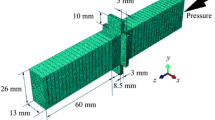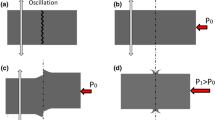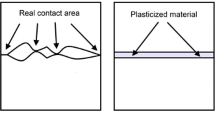Abstract
The linear friction welding (LFW) process—of the type required for production of bladed discs for the next-generation aeroengines—was modeled using numerical methods developed previously. An elastic–viscoplastic material formulation was considered to allow for residual stress calculations to be included in the numerical solution. A study of the evolution of residual stress during the welding and cooling processes was made. It was evident that residual stresses arose primarily as a consequence of the cooling of the part after joining is completed. The sensitivity of predicted residual stress to the applied forge load was investigated and compared with measurements from X-ray diffraction methods. Only small changes in residual stress were predicted for large changes in forge load, supporting the hypothesis that the welding process is only of secondary importance to residual stress formation, after the cooling process. Finally, a sensitivity study was carried out investigating the accuracy of modeling the welding process with a simpler, viscoplastic material law, and only switching to the more computationally demanding elastic–viscoplastic law for the cooling modeling. Predictions suggested that this was a sufficient modeling method, given that stress during the welding stage is almost uncorrelated to that present once ambient temperature is reached.














Similar content being viewed by others
References
J.C. Williams and E.A. Starke: Acta Mater., 2003, vol. 51, pp. 5775-99.
A. Vairis and M. Frost: Wear, 1998, vol. 217, no. 1, pp. 117-31.
A. Vairis and M. Frost: Mater. Sci. Eng. A, 2000, vol. 292, no. 1, pp. 8-17.
A. Vairis and M. Frost: Mater. Sci. Eng. A, 1999, vol. 271, no. 1, pp. 477-84.
P. Frankel, M. Preuss, A. Steuwer, P.J. Withers, and S. Bray: Mater. Sci. Technol., 2009, vol. 25, no. 5, pp. 640-50.
J. Romero, M.M. Attallah, M. Preuss, M. Karadge, and S. Bray: Acta Mater., 2009, vol. 57, no. 18, pp. 5582-92.
R. Turner, J. Gebelin, R.M. Ward, and R.C. Reed: Acta Mater., 2011, vol. 59, no. 10, pp. 3792-3803.
FORGE Software: Transvalor S.A., Parc de Haute Technologie, Sophia Antipolis, France.
JMatPro Software: Thermotech Sente Software, Guildford, UK.
Acknowledgments
The authors would like to acknowledge the EPSRC for financially supporting this work as well as Rolls-Royce plc for the provision of weld specimens. The authors thank Dr. Andrew Walpole, Dr. Stan Nikov (Rolls-Royce plc), and Mike Rowlson for their help. Thanks also are extended to Dr. Michael Preuss for his input on the work.
Author information
Authors and Affiliations
Corresponding author
Additional information
Manuscript submitted July 1, 2011.
Rights and permissions
About this article
Cite this article
Turner, R., Ward, R.M., March, R. et al. The Magnitude and Origin of Residual Stress in Ti-6Al-4V Linear Friction Welds: An Investigation by Validated Numerical Modeling. Metall Mater Trans B 43, 186–197 (2012). https://doi.org/10.1007/s11663-011-9563-9
Published:
Issue Date:
DOI: https://doi.org/10.1007/s11663-011-9563-9




